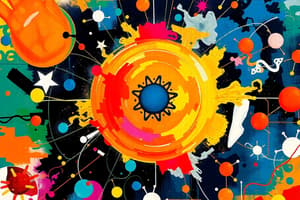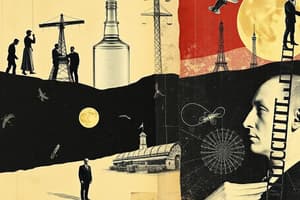Podcast
Questions and Answers
Which of the following best describes the relationship between a hypothesis and a theory in the scientific method?
Which of the following best describes the relationship between a hypothesis and a theory in the scientific method?
- A theory is an initial observation, while a hypothesis is an experiment performed to test that initial observation.
- A hypothesis and a theory are essentially the same thing and can be used interchangeably.
- A theory is a specific guess that explains an observation, while a hypothesis is a broad explanation supported by evidence.
- A hypothesis is a testable statement that explains something observed, while a theory is an explanation for a very general class of phenomena or observations. (correct)
Two essential components that form the framework for modern biological science include:
Two essential components that form the framework for modern biological science include:
- The theory of the Big Bang and the theory of plate tectonics.
- The theory of spontaneous generation and the theory of inheritance.
- The cell theory and the theory of evolution by natural selection. (correct)
- The germ theory and the theory of relativity.
Which is NOT one of the five fundamental characteristics shared by all living organisms?
Which is NOT one of the five fundamental characteristics shared by all living organisms?
- Cells
- Homeostasis (correct)
- Energy
- Evolution
What is the key distinction between the 'pattern' and 'process' components of a scientific theory?
What is the key distinction between the 'pattern' and 'process' components of a scientific theory?
The cell theory, a cornerstone of biology, states that:
The cell theory, a cornerstone of biology, states that:
Pasteur's experiment with swan-necked flasks disproved the hypothesis of spontaneous generation by demonstrating that:
Pasteur's experiment with swan-necked flasks disproved the hypothesis of spontaneous generation by demonstrating that:
The implications of the cell theory suggest that:
The implications of the cell theory suggest that:
What are the two conditions necessary for natural selection to occur within a population?
What are the two conditions necessary for natural selection to occur within a population?
Darwin's concept of 'descent with modification' refers to:
Darwin's concept of 'descent with modification' refers to:
How does natural selection lead to evolutionary change in a population?
How does natural selection lead to evolutionary change in a population?
What is the eventual outcome of populations diverging to form new species?
What is the eventual outcome of populations diverging to form new species?
Why is it inaccurate to describe natural selection as a 'random' process?
Why is it inaccurate to describe natural selection as a 'random' process?
What is the critical role of heritable variation in the process of evolution by natural selection?
What is the critical role of heritable variation in the process of evolution by natural selection?
In artificial selection, what factor determines which individuals produce the most offspring?
In artificial selection, what factor determines which individuals produce the most offspring?
What is a potential long-term consequence of artificial selection, as exemplified by trophy hunting of bighorn sheep?
What is a potential long-term consequence of artificial selection, as exemplified by trophy hunting of bighorn sheep?
What is implied by the statement: 'Natural selection acts on individuals, but evolutionary change occurs in populations'?
What is implied by the statement: 'Natural selection acts on individuals, but evolutionary change occurs in populations'?
What is the relationship between fitness and adaptation?
What is the relationship between fitness and adaptation?
What is the role of chromosomes in the chromosome theory of inheritance?
What is the role of chromosomes in the chromosome theory of inheritance?
According to the chromosome theory of inheritance, what is the relationship between genes and chromosomes?
According to the chromosome theory of inheritance, what is the relationship between genes and chromosomes?
What is the significance of the sequence of nucleotide bases in DNA?
What is the significance of the sequence of nucleotide bases in DNA?
According to the central dogma of molecular biology, what is the flow of genetic information within a cell?
According to the central dogma of molecular biology, what is the flow of genetic information within a cell?
What is the primary role of adenosine triphosphate (ATP) in living organisms?
What is the primary role of adenosine triphosphate (ATP) in living organisms?
According to Darwin and Wallace, how can natural selection lead to macroevolutionary changes, such as the origin of new species?
According to Darwin and Wallace, how can natural selection lead to macroevolutionary changes, such as the origin of new species?
What are some of the reasons that traditional schemes fail to show an accurate representation of a species?
What are some of the reasons that traditional schemes fail to show an accurate representation of a species?
What is the purpose of a phylogenetic tree?
What is the purpose of a phylogenetic tree?
In a phylogenetic tree, what does a branch that does not share recent common ancestor represent?
In a phylogenetic tree, what does a branch that does not share recent common ancestor represent?
What evidence is analyzed to construct a phylogenetic tree?
What evidence is analyzed to construct a phylogenetic tree?
What insight can be gained by comparing the DNA sequences of two different species?
What insight can be gained by comparing the DNA sequences of two different species?
What is the significance of rRNA in constructing the universal tree of life?
What is the significance of rRNA in constructing the universal tree of life?
Which is an example of how the traditional classification schemes have been modified?
Which is an example of how the traditional classification schemes have been modified?
What are the three major domains?
What are the three major domains?
In the Linnaean system of classification, which level is the broadest and most inclusive?
In the Linnaean system of classification, which level is the broadest and most inclusive?
What is the correct format for writing a scientific name in the Linnaean system?
What is the correct format for writing a scientific name in the Linnaean system?
How can carefully designed experiments help biologists understand the natural world?
How can carefully designed experiments help biologists understand the natural world?
What is the first step in the two-step cycle of scientific theory?
What is the first step in the two-step cycle of scientific theory?
What is a key characteristic of a well-designed experiment?
What is a key characteristic of a well-designed experiment?
How do scientists' actions engage with the world?
How do scientists' actions engage with the world?
What was disproven by Scheepers?
What was disproven by Scheepers?
Flashcards
What is Science?
What is Science?
A process for understanding the natural, observable world through observation and experimentation.
Scientific Method
Scientific Method
A continuous process of observation, questioning, hypothesis formation, prediction, and data collection.
Hypothesis
Hypothesis
A testable statement explaining an observed phenomenon.
Theory
Theory
Signup and view all the flashcards
Fundamental Characteristics of Life
Fundamental Characteristics of Life
Signup and view all the flashcards
Cell Theory
Cell Theory
Signup and view all the flashcards
Spontaneous Generation
Spontaneous Generation
Signup and view all the flashcards
Evolution
Evolution
Signup and view all the flashcards
Evolution Definition
Evolution Definition
Signup and view all the flashcards
Natural Selection
Natural Selection
Signup and view all the flashcards
Artificial Selection
Artificial Selection
Signup and view all the flashcards
Fitness
Fitness
Signup and view all the flashcards
Adaptation
Adaptation
Signup and view all the flashcards
Chromosome Theory of Inheritance
Chromosome Theory of Inheritance
Signup and view all the flashcards
Chromosomes
Chromosomes
Signup and view all the flashcards
Central Dogma of Biology
Central Dogma of Biology
Signup and view all the flashcards
Energy Needs
Energy Needs
Signup and view all the flashcards
Natural Selection Leads to...
Natural Selection Leads to...
Signup and view all the flashcards
Speciation
Speciation
Signup and view all the flashcards
Tree of Life
Tree of Life
Signup and view all the flashcards
Phylogeny
Phylogeny
Signup and view all the flashcards
Testing Predictions
Testing Predictions
Signup and view all the flashcards
Study Notes
What is Science?
- Process for understanding the natural, observable world
- Physicist William Lawrence Bragg said the important thing is to find new ways of thinking about things, not obtain new facts
How to Study Science
- Scientists ask questions which are answered by collecting data
- The scientific method is iterative
Scientific Method
- Consists of making observations and formulate general theories
- Refine, expand, or reject existing hypothesis and develop predictions
- Gather data to test predictions
Theory vs Hypothesis
- A hypothesis is a testable explanation for something observed
- A theory is an explanation for a very general class of phenomena or observations
Theories
- Explanation for a general class of phenomena or observations with two components
- Pattern: Something that occurs in the natural world
- Process: Responsible for creating the pattern
- Two theories form the framework for modern biological science: cell theory and evolution by natural selection
Characteristics of Life
- All living organisms share five fundamental characteristics
- Cells
- Replication
- Evolution
- Information
- Energy
Cell Theory
- Proposed by Robert Hooke and Anton van Leeuwenhoek in the late 1660s
- It states that all organisms are made of cells
- All cells come from preexisting cells
- A cell is a highly organized compartment bounded by a plasma membrane with concentrated chemicals in the solution
Origin of Cells
- Cell Theory: All organisms are made of cells (pattern) and all cells come from preexisting cells (process).
- Spontaneous Generation (historical belief): organisms could arise spontaneously, even from nonliving things
- Pasteur's experiment of using different flasks helped prove that the all-Cells theory is what happens
Implications of Cell Theory
- All individuals in a population of single-celled organisms are related by common ancestry
- In multicellular organisms, all cells are connected by common ancestry
Theory of Evolution by Natural Selection
- Charles Darwin and Alfred Russel Wallace, in 1858, made two claims regarding the natural world
- All species are related by common ancestry, and species can change through time
- A species is a distinct, identifiable type of organism
- Characteristics of species can be modified from generation to generation; called descent with modification
Evolution
- Change in the characteristics of a population over time
- A population is a group of the same species which live in the same area and time
- Natural selection explains how evolution occurs
Natural Selection Conditions
- Two conditions must be met for natural selection to occur in a population
- Individuals must vary in characteristics that are heritable
- Certain versions of these heritable traits help individuals reproduce more than other versions
Evolution by Natural Selection
- Heritable traits that lead to increased reproductive success become more common
- Characteristics change as a result of natural selection acting on individuals
- Natural selection acts on individuals and evolutionary change occurs in populations
- Speciation occurs when populations diverge to form new species
Artificial Selection
- Changes in populations occur when humans select which individuals will produce the most offspring Repeating this process leads to changes in a domesticated population over time
Fitness vs Adaptation
- Fitness is the ability of an individual to produce offspring
- Individuals with high fitness produce many surviving offspring
- Adaptation is a trait that increases the fitness of an individual in a particular environment
Life Processing Information
- The chromosome theory of inheritance provides the foundation to answering questions about the source of heritable traits
- Third unifying idea of biology
Chromosomal Theory of Inheritance
- Proposed in 1902 by Walter Sutton and Theodor Boveri
- Hereditary information is encoded in genes
- Genes are units located on chromosomes
- 1950s: chromosomes are molecules of deoxyribonucleic acid, or DNA
DNA
- Basic unit is chromosomes, molecules of deoxyribonucleic acid, or DNA
- DNA is the hereditary material
- Genes are segments of DNA that code for cell products
- Each strand of its double helix is made up of four building blocks (A, T, C, G)
- It encodes the needed information for growth and reproduction.
DNA Structure
- James Watson and Francis Crick proposed that DNA is a double-stranded helix
- Two strands are connected by building blocks
- A pairs with T
- C pairs with G
- This pairing is preserved, which allows DNA to be copied
Central Dogma
- DNA codes for ribonucleic acid, or RNA, which codes for proteins
- Proteins determine physical traits
Life Requires Energy
- Chemical reactions take place inside cells and require energy
- Organisms have two fundamental nutritional needs:
- Chemical energy in the form of adenosine triphosphate, or ATP
- Molecules that build DNA, RNA, and proteins
Tree of Life (Phylogenetic Tree)
- Darwin and Wallace also stated natural selection can lead to changes within species, as well as between species
- The tree depicts a divergence process in which natural selection has caused populations of one species to diverge and change
Tree of Life
- A family tree of organisms that describes relationships with a single ancestral species at its base
- Phylogeny is the actual genealogical relationships among all organisms
- It's built using computer programs looking for the connections between species
Molecules and the Tree of Life
- Biologists study RNA and DNA from different organisms to uncover the genetic connections
- Carl Woese used the small unit rRNA in looking evolutionary relationships among organisms
- Comparing the sequences may indicate a closer relationship
Analyzing Genetic Variation
- Genetic analysis can be useful for determining how closely the species are related
- A-T-A-T-G-G-A-G is an example of green algae DNA
Phylogenetic Trees
- Diagrams that show the relationships between species
- The branches that share ancestors show that they are related
- What is more closely related: A & B or A & E?
Tree of Life Estimation
- Constructed through complex branching arrangements consistent with existing genetic data
- Universal tree or tree of life that includes a diverse array of species
- Nodes represent common ancestors
- Can show how species are related, three main group of organisms: Eukaryotes in the domain eukarya and prokaryotes in the domains bacteria and archea
Naming Branches
- Taxonomy is the practice of naming and classifying organisms
- A taxon refers to a named group
- Carl Linnaeus established the classification system in 1735
- Each organism has unique two-part name
- Made scientific classification levels
Hypothesis Testing
- Science tests ideas about how the natural world works by testing the predictions made by hypotheses
- Hypothesis testing is a two-step process
- State the hypothesis as precisely as possible and list the predictions it makes
- Design an observational or experimental study capable of testing those predictions
- Food competition hypothesis: Giraffes evolved long necks by natural selection because those reach food unavailable to others
- Simmons and Scheepers tested the food competition, and one of the three was incorrect
- The sexual competition states that winner ones have higher success and sire more offspring
Good Experimental Designs
- Include a reference or control group to check for influential factors
- Conditions must be constant or as equivalent as possible to eliminate other variables
- Must repeat test with larger sample sizes
Studying That Suits You
Use AI to generate personalized quizzes and flashcards to suit your learning preferences.




